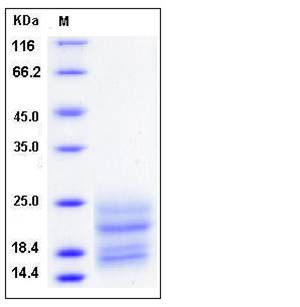Human TNFRSF13B / TACI / CD267 Protein (His Tag)
CD267,CVID,CVID2,IGAD2,RYZN,TACI,TNFRSF14B
- 100ug (NPP4300) Please inquiry
| Catalog Number | P11937-H08H |
|---|---|
| Organism Species | Human |
| Host | Human Cells |
| Synonyms | CD267,CVID,CVID2,IGAD2,RYZN,TACI,TNFRSF14B |
| Molecular Weight | The recombinant human TNFRSF13B consists of 130 amino acids and has a predicted molecular mass of 14.8 kDa. In SDS-PAGE under reducing conditions, the apparent molecular mass of rhTNFRSF13B is approximately 18-24 kDa. |
| predicted N | Ser 2 |
| SDS-PAGE |  |
| Purity | > 90 % as determined by SDS-PAGE |
| Protein Construction | A DNA sequence encoding the human TNFRSF13B isoform 2 (O14836-2) extracellular domain (Ser 2-Thr 120) was expressed, with a polyhistidine tag at the C-terminus and a signal peptide at the N-terminus. |
| Bio-activity | |
| Research Area | Cancer |Invasion microenvironment |Angiogenesis |Cytokine & Receptor |Tumor Necrosis Factor (TNF) & Receptor |TNF Receptor | |
| Formulation | Lyophilized from sterile PBS, pH 7.4 1. Normally 5 % - 8 % trehalose and mannitol are added as protectants before lyophilization. Specific concentrations are included in the hardcopy of COA. |
| Background | Tumor necrosis factor receptor superfamily, member 13B (TNFRSF13B) also known as Transmembrane activator and CAML interactor (TACI) and CD267 antigen, is a member of the tumor necrosis factor receptor superfamily. TNFRSF13B is a trimeric cytokine receptor that binds tumor necrosis factors (TNF). The receptor cooperates with an adaptor protein which is important in determining the outcome of the response. Members of the TNF receptor superfamily (TNFRSF) have crucial roles in both innate and adaptive immunity and in cellular apoptosis process. Apoptosis is a cell suicide mechanism that enables metazoans to control cell number in tissues and to eliminate individual cells that threaten the animal's survival. Certain cells have unique sensors, termed death receptors or tumour necrosis factor (TNFR), on their surface. Tumour necrosis factors (TNFR) detect the presence of extracellular death signals and, in response, they rapidly ignite the cell's intrinsic apoptosis machinery. TACI/TNFRSF13B/CD267 induces activation of the transcription factors NFAT, AP1, and NF-kappa-B and plays a crucial role in humoral immunity by interacting with a TNF ligand. |
| Reference |
